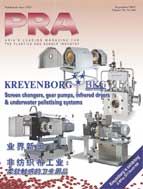 |
 |
In this Edition September 2011 |
LEAD FEATURE |
COMPANY NEWS |
MATERIALS NEWS |
MACHINERY NEWS |
ENVIRONMENT NEWS |
INJECTION MOULDING ASIA |
RUBBER JOURNAL ASIA |
PRA September 2011 Electronic Issue Now Available |
Materials News
New polymer for lowering cost of lithium batteries
R
esearchers at UK-based University of Leeds have invented a new type of polymer gel that can be used to manufacture lithium batteries more cheaply, without compromising performance.The technology has been licensed to Livermore-based Polystor Energy, which is conducting trials to commercialise cells for portable consumer electronics.
Researchers believe that the new material could replace the liquid electrolytes currently used in rechargeable lithium cells. Furthermore, the gel can be made into a thin, flexible film via a fully automated process that is fast, efficient and potentially inexpensive.
Rechargeable lithium-ion batteries are the preferred power source for a wide range of portable consumer electronics such as laptops, digital cameras, mobile phones and MP3 players. The traditional configuration for the batteries is based on cells (sealed containers), which contain a liquid chemical filler and a porous polymer film separator. Lithium ions carry an electrical charge between the two battery electrodes, while the separator holds the electrodes apart to prevent short-circuiting.
The new polymer gel removes the need for the separator. The researchers also developed a patented manufacturing process called extrusion/lamination which sandwiches the gel between an anode and cathode at high speed (10 m/minute) to create a highly conductive strip only nanometres thick.
The resulting polymer gel film can be cut to any size, permitting a fully-automated process which is cited as both cost effective and safe. The lamination process also seals the electrodes together so that there is no excess flammable solvent or free liquid electrolyte.
The university says, "The polymer gel looks like a solid film, but it actually contains about 70% liquid electrolyte and is made using the same principles as producing an edible jelly where lots of hot water is added to a polymer/electrolyte mix, rather than gelatine. As the solution cools it sets to form a solid but flexible mass."
As well as being safe and damage-tolerant, the flexible cells can be shaped and bent to fit the geometries of virtually any device.


